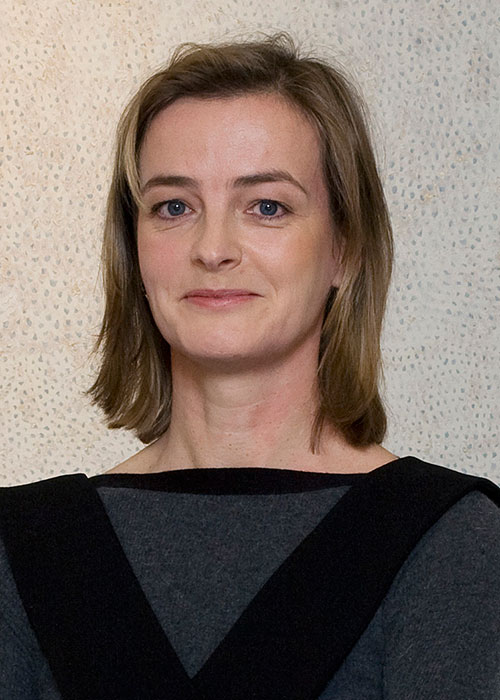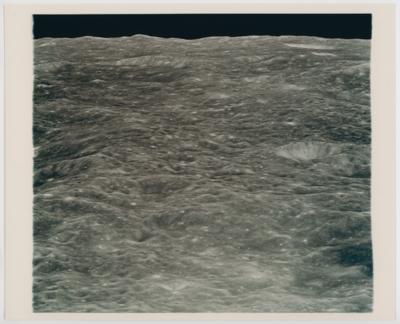Frank Borman (Apollo 8)
The spectacular lunar farside horizon, as first seen by humans, 21-27 December 1968
Vintage chromogenic print on fiber-based paper, printed 1968, (NASA AS8-14-2453), with "Tucker" collection credit stamp and "A KODAK PAPER" watermark on verso, (NASA/North American Rockwell), 20,3 x 25,4 cm
Borman took this photograph looking west on rugged mountainous terrain never before seen by man, as he enjoyed a lonely view of the spectacular backside of the Moon during Lovell and Anders’ sleep period on orbit 8. Latitude / longitude: 12.3° S / 113° E.
In this oblique photograph, the foreshortening effects of the 250mm telephoto lens provide an interesting portrayal of lunar farside relief.
[original NASA caption for the photograph] After inserting into lunar orbit, the Apollo 8 astronauts looked down on rugged terrain never before seen by man. This scene is typical of farside terrain illuminated by a sun that is nearly directly overhead. A surface consisting of craters superimposed on older craters extends about 570 kilometers (350 statute miles) to the horizon. Width of view at the horizon is 150 kilometers (94 statute miles)
“The back side is more mountainous than the front side. [...] Someone said it was like papier-mâché. Well, right, it’s all shades of gray. There is no color.”
James Lovell (Chaikin, Voices, p. 41)
Literature:
Moon: Man’s Greatest Adventure, Thomas, ed., pg. 159.
Specialist: Mag. Eva Königseder
 Mag. Eva Königseder
Mag. Eva Königseder
+43-1-515 60-421
eva.koenigseder@dorotheum.at
27.09.2023 - 15:04
- Realized price: **
-
EUR 1,950.-
- Estimate:
-
EUR 600.- to EUR 800.-
- Starting bid:
-
EUR 100.-
Frank Borman (Apollo 8)
The spectacular lunar farside horizon, as first seen by humans, 21-27 December 1968
Vintage chromogenic print on fiber-based paper, printed 1968, (NASA AS8-14-2453), with "Tucker" collection credit stamp and "A KODAK PAPER" watermark on verso, (NASA/North American Rockwell), 20,3 x 25,4 cm
Borman took this photograph looking west on rugged mountainous terrain never before seen by man, as he enjoyed a lonely view of the spectacular backside of the Moon during Lovell and Anders’ sleep period on orbit 8. Latitude / longitude: 12.3° S / 113° E.
In this oblique photograph, the foreshortening effects of the 250mm telephoto lens provide an interesting portrayal of lunar farside relief.
[original NASA caption for the photograph] After inserting into lunar orbit, the Apollo 8 astronauts looked down on rugged terrain never before seen by man. This scene is typical of farside terrain illuminated by a sun that is nearly directly overhead. A surface consisting of craters superimposed on older craters extends about 570 kilometers (350 statute miles) to the horizon. Width of view at the horizon is 150 kilometers (94 statute miles)
“The back side is more mountainous than the front side. [...] Someone said it was like papier-mâché. Well, right, it’s all shades of gray. There is no color.”
James Lovell (Chaikin, Voices, p. 41)
Literature:
Moon: Man’s Greatest Adventure, Thomas, ed., pg. 159.
Specialist: Mag. Eva Königseder
 Mag. Eva Königseder
Mag. Eva Königseder
+43-1-515 60-421
eva.koenigseder@dorotheum.at
|
Buyers hotline
Mon.-Fri.: 10.00am - 5.00pm
kundendienst@dorotheum.at +43 1 515 60 200 |
| Auction: | The Beauty of Space - Iconic Photographs of Early NASA Missions |
| Auction type: | Online auction |
| Date: | 27.09.2023 - 15:04 |
| Location: | Wien | Palais Dorotheum |
| Exhibition: | Online |
** Purchase price incl. charges and taxes
It is not possible to turn in online buying orders anymore. The auction is in preparation or has been executed already.

